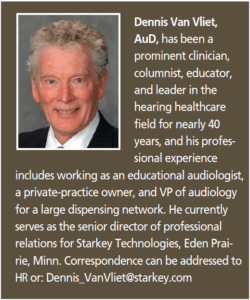Final Word | January 2015 Hearing Review
I was probably only 6 or 8 years old, and the family on my father’s side had gathered at the home of my great grandparents. I was very aware that I was very lucky to have two sets of living grandparents, as well as a pair of great grandparents. My cousins and I were talking to “Grandpa Dickey,” as we called him; it was short for their surname, Dickinson. I think one of the cousins had received a harmonica as a gift. Grandpa Dickey, who was probably in his late 80s at the time, shared that he had played the harmonica when he was younger. This excited us, because about all we could produce on the device were tuneless honks and shrieks. Honks and shrieks were good for a few laughs, but we wanted a little more.
The old gentleman, who was typically quiet and reserved, started tapping his foot, warmed up with a few preparatory deep breaths, and blew out a lively few bars of a tune, probably something like She’ll Be Coming Around the Mountain. He stopped before the end because he was gasping for air, having given all he had to get that far in the song. “More, Grandpa, more!” we shouted in unison.
My grandmother chased us outside, warning that we had nearly killed the old guy and needed to leave him alone. We were disappointed, but respected that his capabilities were limited, given his age and health. It was only that one time we heard him play, but it is quite a bright memory that I cherish.
As I think about that moment of my great grandfather reaching his limit for playing the harmonica, I realize that it illustrates what can happen with communication and aging. Hearing, auditory and cognitive processing, memory, and filtering capabilities naturally change with age, and adjustments must be made. My great grandfather didn’t have many options but to stop playing the harmonica.
Fortunately, we can offer a number of good options for our patients. What used to be lumped into “realistic expectations” counseling is now morphing into a much more detailed and structured educational process that includes the expectations portion, but also explains why there are problems and offers clear specifics on what actions to take.
Importantly, the treatment plan should include specific behavioral changes that are needed to optimize communication. One of my favorite counseling tips is to remind the typical first-time user that they have probably earned the privilege of eating in restaurants with cloth tablecloths: stay away from hard surfaces and a lively noise level if you want to have conversation during a dinner out.
I cannot rely on that still-valid but insufficient advice for today’s patient. A nice restaurant with cloth tablecloths may have a boisterous table of 10 seated next to them. I need to provide the patient with specific steps to take to make that situation better. There is a very specific action that we discuss that involves asking the noisy group to quiet down (also known as the “Shut up!” algorithm). Other options are to ask for a different seat or leaving altogether for a quieter environment.
Hardware options are good today, but the user needs to understand how to use the controls and accessories for optimal benefit. If the user doesn’t want to “bother” others with remote microphones and better seating arrangements at the table, this needs to be a factor in their level of expectation. If they are disappointed in their performance in noise and haven’t followed the treatment recommendations, the onus is on the user to change behavior before complaining to the professional.
Computer and tablet-assisted training is a growing field that can apply directly to our patients. It is encouraging that there are many choices for listening and memory training becoming available in apps and online, but remember that there is no substitute for a structured plan that is monitored and guided by the hearing care professional. Buying the book doesn’t ensure knowledge.

Will your patients be able to play the harmonica? It depends on their talents, interest, and experience. I still can only produce shrieks and honks if I pick up a harmonica, but when I go out to eat, I’ll select a restaurant with more absorptive surfaces like cloth tablecloths, and ask for a booth if the environment is too noisy. I might even sneak a remote microphone near that person with the soft voice at the end of the table.
Citation for this article: Van Vliet D. Limiting Factors and the Patient’s Role in Successful Hearing Strategies. Hearing Review. 2015;21(1):50.




